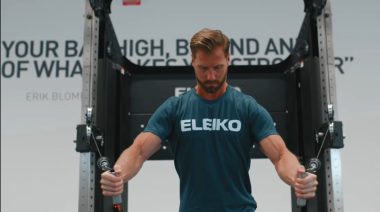Last week I shared what I believe to be the four greatest inventions in strength training. But four is a pretty small number and there are a lot of useful and amazing devices in our fitness realm.
So here are four more fine inventions that have facilitated effective training over the years.
1. Pulldown Machine
Whether you are a male or female you need to strengthen the posterior upper-back musculature. Pull ups and chin ups are outstanding exercises for this.
There is an obvious problem, though. A majority of females and a number of males cannot perform these exercises in a full-range, controlled manner for multiple repetitions with their body weight. (Yes, I wrote “controlled.” Please, none of those embarrassing kipping circus actions.)
I could not determine the original inventor, but the adjustable-resistance seated pulldown machine was a genius idea due to the aforementioned problem. Can’t raise your body weight? No problem. Adjust the resistance to fit your needs.
Many patented pulldown devices currently exist in gyms throughout the world -selectorized, plate-load, single pulley, double pulley, single movement arm, double movement arm, and assisted resistance. They all alleviate the “stuck with your body weight” issue. Not to mention, injury prevention and functional strength are about joint muscle balance. If we did not have these devices, we’d be more prone to shoulder injuries.
2 Hex or Trap Deadlift Bar
If you want to glean the benefits of deadlifting independent of a standard barbell, someone was smart enough years ago to design a device that better aligned with our skeletal leverage and center of gravity. It is called the “hex” or “trap” bar. It allows you to work the larger muscles of your body – the upper and lower back, abdominals, glutes, quads, and hamstrings – with better technique and less lumbar stress.
Similar to when you barbell squat, if you have poor skeletal leverage (i.e., long legs, short torso, and short arms), deadlifting properly with a standard bar will be difficult. The trap bar will at least allow you to remain in better position throughout the lift.
3. Dumbbells
I know what you’re thinking. Dumbbells? Really? Well, someone had to invent them. They just didn’t appear out of thin air. And believe it or not, they had their genesis in ringing church bells. Over time, people figured out these could be used for exercise, akin to Indian clubs.
Dumbbells are even more versatile than the barbell due to the many exercises you can perform:
- Various upper body pressing and rowing exercises
- Direct bicep, tricep, and forearm work
- Single joint upper body movements, like chest flies, front and side lateral raises, bent-over raises, shrugs, and pullovers
- Resisted chin ups and bar dips with a dumbbell hung from a belt
- Multi-joint leg exercises, like the squat, lunge, goblet squat, side squat, and one-legged squat
- Single joint leg movements like the stiff-legged deadlift, Romanian deadlift, and calf raise
- Numerous abdominal flexion and rotation exercises
- Farmer’s walk
- They also make great door stops
4. Selectorized and Plate-Load Machines
Machines have received a bad rap over the years. The entire “free weights versus machines” argument needs to be buried and forgotten. The truth is, your muscles are stupid and don’t know what they are being resisted by. A large rock? A dumbbell? A keg?
Muscle tissue simply adapts to tension created in the fibers and if it’s getting its ass kicked. Knowing that, here is the upside of machines:
- If designed properly, machines put the exerciser a position to optimally target a certain muscle or group of muscles.
- You can train to volitional muscular fatigue safely with machines.
- You don’t necessarily need a spotter on most machines.
- They add more variety to your training program.
Some people cannot barbell squat effectively due to poor leverage. They may have long thigh bones and a short torso. They may possess poor ankle and hip-joint flexibility, which prohibits proper form. If you have poor biomechanical leverage, don’t kill yourself attempting to squat with a barbell on your back.
Enter the leg press machine. The leg press is a great tool for those with sub-par barbell-squatting genetics. It’s also a great device for anyone wishing to maximally fatigue the legs regardless of inherent leverage. Here is s pictorial progression of leg press devices.
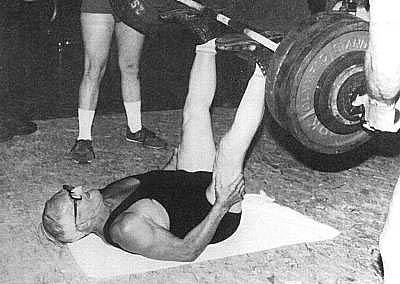
Unsupported. Don’t try this at home.
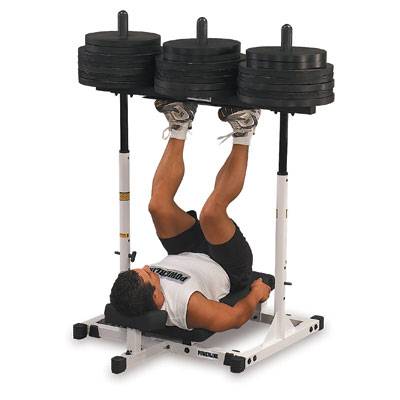
Overhead plate-load machine made by Powerline Fitness.
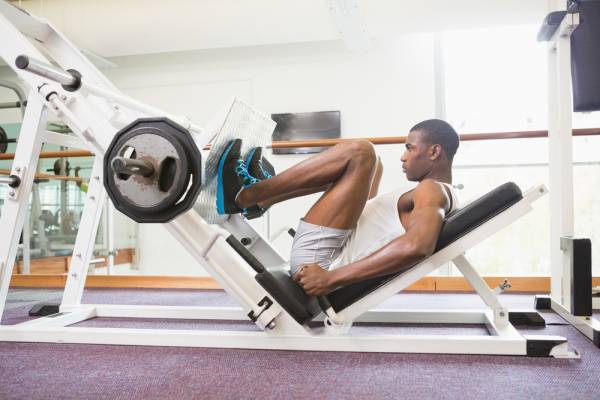
45-degree angle plate-load machine.
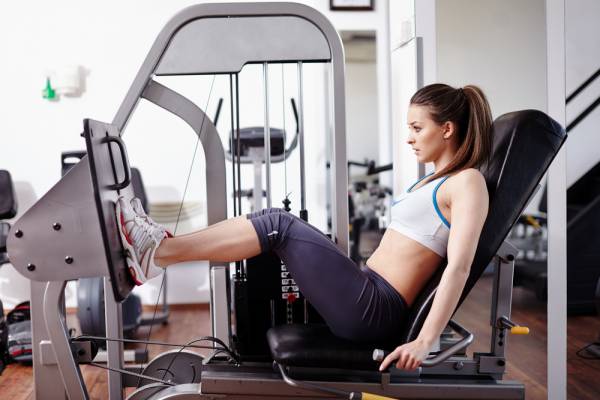
Modern-day selectorized leg press machine.
On the downside, the majority of leg press machines offer incomplete hip extension. When you press the resistance away to complete knee extension, complete hip extension is never realized. That is, your thighs do not align parallel to the torso. Leg presses are still great lower-body tools if you work hard.
It’s too bad the Hammer H-Squat machine is no longer manufactured. This machine offered complete hip extension with concomitant knee extension.
But the issues with the H-Squat design were threefold:
- It had a large floor footprint.
- You had to climb up into it.
- You needed a parachute to get out of it.
Regardless, it was a step in the right direction. Gary Jones (son of the late Arthur Jones) designed this piece of equipment. Go online and I’m sure you can find one to put in your gym.
So, there you have it. Four more of the greatest inventions in strength training history. Feel free to respond with your opinion in our discussion forums.
Check out these related articles:
- The Greatest Inventions in Strength Training History
- Wider Grip, Wider Lats: Science Tests the Broscience
- 7 Insane Leg Workouts That May Make You Take Up Basket Weaving
- What’s New On Breaking Muscle Today
Photos 1, 4, and 5 courtesy of Shutterstock.

